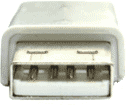USB 2 Pinout (Type A and Type B). Signals and wire colors
USB 2, USB 1 pinouts and signals. Wire colors
USB 1.0 specification introduced in 1994. USB is a likely solution any time you want to use a computer to communicate with devices outside the computer.
USB 2.0 is the successor standard was released in 2000 with the new transfer mode Hi-speed that can transfer data at up to 480 Mbit/s (40x times higher the rate of USB 1.0).
USB 1.0 and USB 2.0 are: half duplex - can either send or receive data, power usage - up to 500 mA per one host controller.
The interface is suitable for one-of-kind and small-scale designs as well as mass-produced, standard peripheral types.
USB 2 (Type A) pinout
 |  |
 |  |
USB 2 Pins
| Pin | Name | Direction | Color | Description |
|---|---|---|---|---|
| 1 | V+ | red | +5 V power | |
| 2 | D- | ←→ | white | Data - |
| 3 | D+ | ←→ | green | Data + |
| 4 | GND | black | Ground |
USB 2 (Type B) pinout
 |  |
| Pin | Name | Direction | Color | Description |
|---|---|---|---|---|
| 1 | V+ | red | +5 V power | |
| 2 | D- | ←→ | white | Data - |
| 3 | D+ | ←→ | green | Data + |
| 4 | GND | black | Ground |
USB Mini/Micro pinout
 |
| Pin | Name | Direction | Color | Description |
|---|---|---|---|---|
| 1 | V+ | red | +5 V power | |
| 2 | D- | ←→ | white | Data - |
| 3 | D+ | ←→ | green | Data + |
| 4 | ID | any | Host/slave detect (USB OTG ID) | |
| 4 | GND | black | Ground |
USB 2 and USB 1 speeds
| Pin | Version | Speed |
|---|---|---|
| 1 | USB 1.x Low-Bandwidth 1996 | 1.5 Mbit/s (192 kB/s) |
| 2 | USB 1.x Full-speed 1996 | 12 Mbit/s (1.5 MB/s) |
| 3 | USB 2.0 Hi-speed 2000 | 480 Mbit/s (60 MB/s) |
| 4 | USB 3.0 SuperSpeed 2010 | 5 Gbit/s (625 MB/s) |
| 5 | USB 3.1 SuperSpeed+ 2013 | 10 Gbit/s (1,250 MB/s) |
Our software allows you monitor, log, debug and test your RS232 or COM ports.